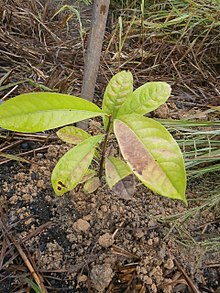Aniba
| Aniba | |
|---|---|

| |
| Scientific classification | |
| Kingdom: | Plantae |
| Clade: | Tracheophytes |
| Clade: | Angiosperms |
| Clade: | Magnoliids |
| Order: | Laurales |
| Family: | Lauraceae |
| Genus: | Aniba Aubl. |
| Species | |
|
Several, see text | |
| Synonyms | |
|
Aydendron Nees | |
Aniba is an American neotropical flowering plant genus in the family Lauraceae. They are present in low and mountain cloud forest in Caribbean islands, Central America, and northern to central South America.
Description
[edit]They are shrubs or trees up to 25 m high, hermaphrodites. The leaves are alternate, entire, and elliptical or narrowly elliptical. The inflorescences are paniculate and axillary, the flowers are arranged in cymes essentially, and those strictly opposite side are small. The fruit is a berry-like drupe dispersed mostly by birds. Fruits are 3 cm long and 1.5 cm wide, with deep domes, and warty. Many species have a valuable timber in yellow wood, others have the wood and bark pleasantly scented. The oils extracted from certain species are used as ingredients in the manufacture of perfumes.
Ecology
[edit]Aniba is a genus of great ecological importance. It currently includes 41 species, classified into six different subgroups, in which the woody structures are almost undifferentiated; the differences are ecological adaptations to different environments over a relatively dry-wet climate. Species in less humid environments are smaller or less robust, with less abundant and thinner foliage and have oleifera cells that give trees a more fragrant aroma.
Found throughout the Guyanas and the Amazon region, and also in the Pacific coastal areas of Colombia, they grow mostly in tropical forests and Andean cloud forest, but have also been found in stubbles and pastures. Distribution of Aniba extends from the islands of the Antilles in the Caribbean to Central America, Nicaragua, Costa Rica, the Guyanas, Venezuela, Colombia, and Peru in the coastal ranges and interior in wet areas, the Andes, and to dry regions of central and southern Brazil.
They do not form large stands, but rather small groups of trees with densities up to one individual per five hectares. Due to the low density, exploitation of the natural populations is to the detriment of the rainforest. Overexploitation of the easily accessible trees of the rainforest has been reducing exports since the mid-1990s. Due to the distribution in inaccessible rainforest regions and its low density, it is hard to survey population trends in figures, but overexploitation is evident. [1]
Fourteen of the most known trees are used by the timber industry. In general, the wood from Aniba species has a high commercial value. The woods are typically yellowish with a greenish hue when fresh, becoming brown or olive on exposure to air. Narrow sapwood is light yellowish. Luster is medium to high; grain is straight to interlocked; texture is fine to medium; they have a spicy odor, and the taste may be distinctive.[2] [3]
Species
[edit]49 species are currently accepted:[4]
- Aniba affinis (Meisn.) Mez – southeastern Colombia, southern Venezuela, and northern Brazil
- Aniba bracteata (Nees) Mez – Puerto Rico, Lesser Antilles, Costa Rica, and Ecuador
- Aniba burchellii Kosterm. – southeastern Colombia, southern Venezuela, and Brazil
- Aniba canelilla Mez
- Aniba cinnamomiflora C.K.Allen
- Aniba citrifolia (Nees) Mez
- Aniba coto (Rusby) Kosterm.
- Aniba cylindriflora Kosterm.
- Aniba desertorum (Nees) Mez
- Aniba excelsa Kosterm.
- Aniba ferrea Kubitzki 1982
- Aniba ferruginea Kubitzki 1982
- Aniba firmula (Nees & Mart.) Mez, 1889
- Aniba flexuosa A.C.Sm., 1935
- Aniba foeniculacea Mez, 1906
- Aniba fragrans Ducke 1925
- Aniba guianensis Aubl.
- Aniba heterotepala van der Werff
- Aniba hostmanniana (Nees) Mez
- Aniba hypoglauca Sandwith
- Aniba inaequabilis Da Matta
- Aniba intermedia (Meisn.) Mez 1889
- Aniba jenmanii Mez
- Aniba kappleri Mez
- Aniba lancifolia Kubitzki & W.A.Rodrigues
- Aniba magnifica W.Palacios
- Aniba megaphylla Mez
- Aniba muca (Ruiz & Pav.) Mez
- Aniba novo-granatensis Kubitzki 1982
- Aniba panurensis (Meisn.) Mez
- Aniba parviflora (Meisn.) Mez 1889
- Aniba pedicellata Kosterm. 1938
- Aniba percoriacea C.K.Allen 1964
- Aniba permollis (Nees) Mez
- Aniba perutilis Hemsl. 1894
- Aniba pilosa van der Werff 1994
- Aniba puchury-minor (Mart.) Mez
- Aniba ramageana Mez
- Aniba riparia (Nees) Mez
- Aniba robusta (Klotzsch & P.Karst.) Mez 1889
- Aniba rosaeodora Ducke 1930
- Aniba santalodora Ducke 1950
- Aniba subbullata H.Ribeiro & P.L.R.Moraes
- Aniba sulcata Benoist 1929
- Aniba vaupesiana Kubitzki 1982
- Aniba venezuelana Mez 1889
- Aniba viridis Mez
- Aniba vulcanicola van der Werff 1994
- Aniba williamsii Brooks 1931
References
[edit]- ^ "CoP15-de". www.dcsp.org. Archived from the original on April 25, 2012.
- ^ "Estudio Anatómico Del Leño De Ocho Especies Del Género Aniba Aublet (Lauraceae)" [Anatomical Study of the Log of Eight species of Genus Aniba Aublet (Lauraceae)] (PDF) (in Spanish). Archived from the original (PDF) on 10 May 2018.
- ^ Plantamed Spp.
- ^ Aniba Aubl. Plants of the World Online, Kew Science. Accessed 17 December 2022.
- Flora de Nicaragua
- "USDA, ARS, National Genetic Resources Program. GRIN". National Germplasm Resources Laboratory, Beltsville, Maryland.
